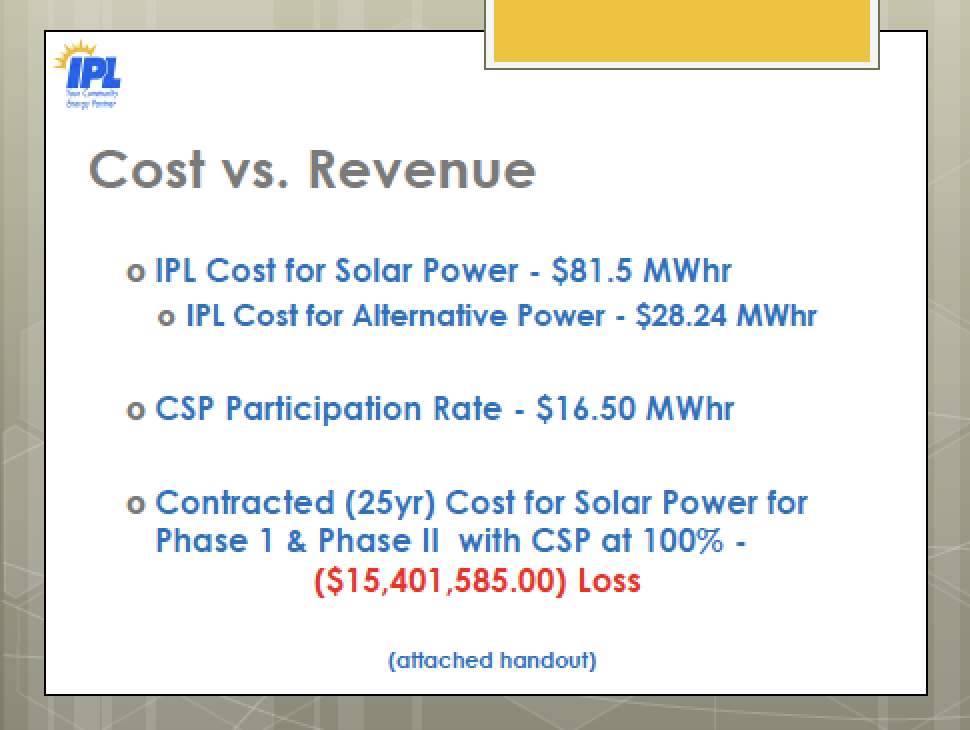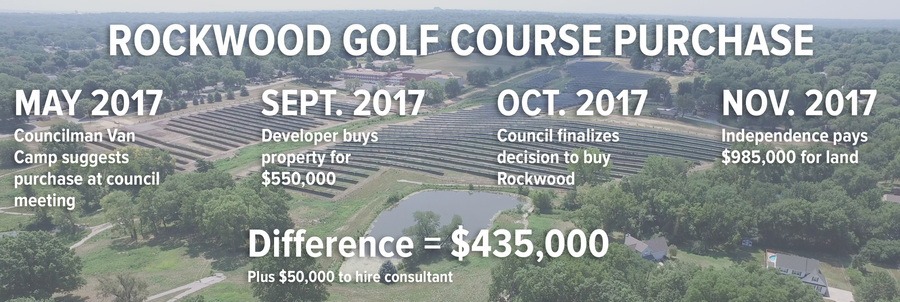Updated Sept. 28, 2018 - The City Council is directing the City Manager to remove caps on community solar and buy up to 100% of the normal usage. Currently customers, in general, are capped at purchasing 40% or less of their normal electrical usage
Is the city Covering its Costs for Community Solar: Initial report Says no though subsequent report says Yes; Opinions Vary
Independence Power and Light (IPL) will lose $15 million over a 25-year period for its aggressive community solar program, according to an analysis by IPL staff, or at least that was the initial report.
Subsequently, the issued a city memo saying its costs are covered by what is being charged. The city provided a three-month tabulation (June - August 2018) showing expenses and revenue from its ambitious community solar projects.
The figures show the community solar projects making $371,000 over the three summer months. Of that, $90,000 is from IPL customers who voluntarily signed up for community solar and agreed to pay a small surcharge on community solar they committed to buy.
The initial loss figure was contained in a staff report prepared for Aug. 23rd Public Utilities Advisory Board.
The 12-page staff report, prepared at the PUAB's request, is the clearest picture of the economics of the renewable energy projects which have enjoyed strong City Council support. The $15 million loss reflects a 25-year cost of community solar compared to currently available cheaper power.
After the city provided the revised figures, Randy Hughes (he previously worked for IPL on rates) wrote a guest column for The Examiner making the cost the community solar increases costs for rate payers because cheaper energy alternatives are available.
There has been a strong response to the community solar farms.
The initial 3.0 megawatt hour community solar project - located on Bundschu Road - is 100% subscribed. And the larger 8.4 MW project is 48% subscribed as of Aug. 16, according to the staff report.
Customers pay a slighter higher fee for solar but can lock in the current rate for up to 20 years for 40% of their total utility bill.
In 2016, IPL began exploring community solar as a way to gain experience with sun-generated energy. Competitive bids were taken and MCPower won the contract.
The IPL staff assessment, at that time, was energy costs would be increasing from a carbon tax, there would be new restrictions on fracking and overall higher natural gas prices.
There was a projected breakeven of 8 to 10 years. The new analysis shows a substantial guaranteed loss.
Community solar was also seen as a way dissuade individuals from installing solar panels on their roof, generating their own energy and potential revenue loss to the city-owned utility.
Leon Daggett, IPL director, at the time commented:
“My job, as a director, is to make sure Mrs. Smith is represented in this whole thing. She shouldn’t subsidize other ratepayers. That’s why I don’t like rooftop solar. So I thought, ‘How do we give our citizens the ability to participate in solar. So we came up with the idea of a solar farm.”
The idea of community solar was discussed in the community and city officials began promoting the idea of Independence becoming the "greenest city in the state."
Ground was broken in September 2016 and the Bundschu site online in March 2017.
The staff report figures shows the first 3.0 megawatt project will lose $4 million (over the 25-year period) because of the cost differential between price to purchase solar and what is being charged.
The projected loss balloons as the locked in loss adds up with the major 8.4 megawatt second phase - another 4.0 megawatts at the Bundschu site and 4.4 megawatts at the former Rockwood golf course - which is coming online.
The Rockwood project has been controversial for other reasons.
Neighbors were unhappy over the elimination of green space and felt uninformed about the project. Channel 41 did an investigative story on the project focusing also on the land transaction.
The city purchased the 94-acre site in November 2017 and paid $985,000 for the property and negotiated at 30-year lease for 31 acres with MCPower for $500,000.
Graphic from the Channel 41 story
The second phase of community solar expansion was not competitively bid. MCPower terms from the first contract were merely extended.
Even as the second phase was nearing completion, the city actively explored adding another three community solar farms by issuing a Request for Proposal (RFP) in May. A pre-proposal June meeting showed outside interest in the projects and some indications of lower charges for solar-generated power. The RFP was retracted in June.
The decision to expand community solar was pressed by the City Council prior to the completion of a master energy study which will provide various energy scenarios so the IPL can "supply an affordable, reliable, and environmentally friendly supply of capacity and energy for the next 20 years."
Lower cost wind power is an option for expanded renewal energy, but there has been a strong push for the community solar projects because it creates local jobs where wind energy does not.
The master energy plan should be publicly presented in the next several weeks and is expected to recommend eventual closure of the city-owned Blue Valley power plant because it runs infrequently and is inefficient.






